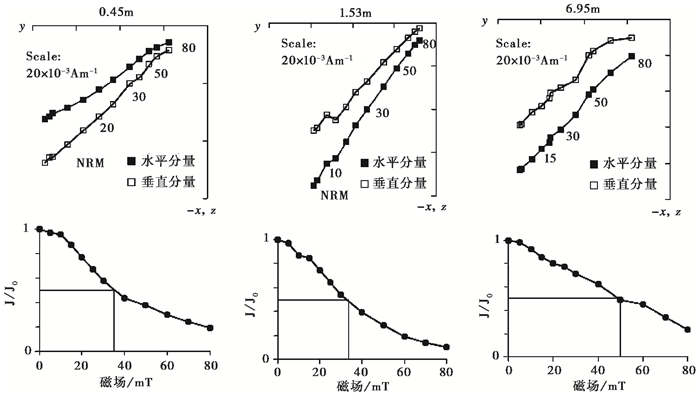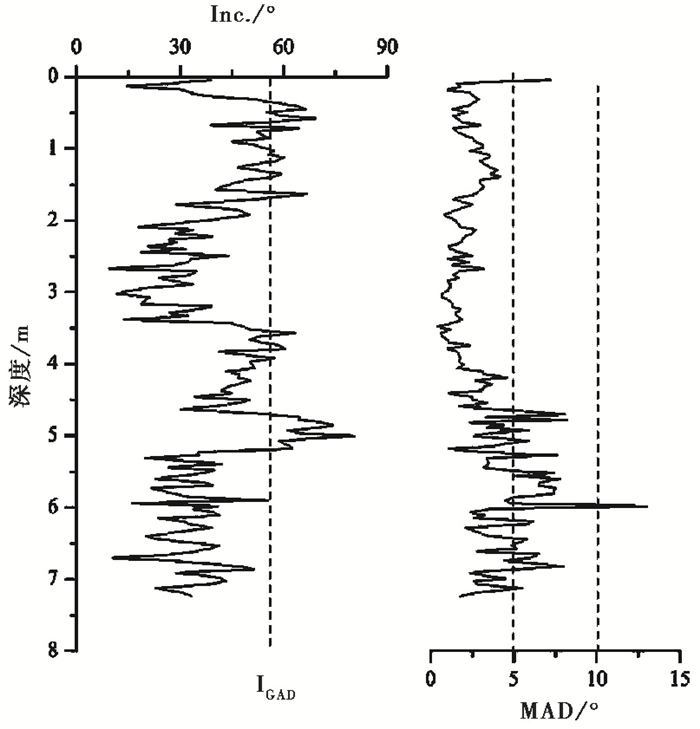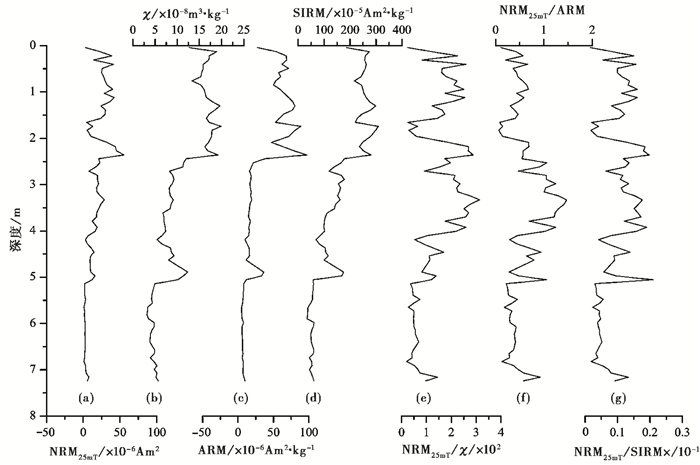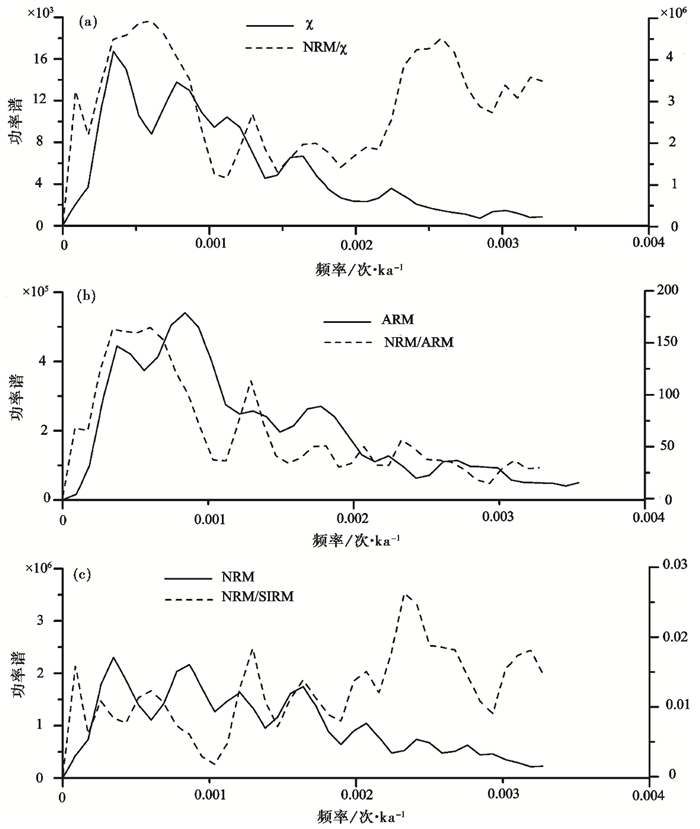磁极性地层是新生代气候变化和古环境年代学研究中最重要的方法之一,具有全球可对比性、独立于气候环境变化、普遍适用性等优势[1],在第四纪和更长时间尺度的年代学研究中发挥着举足轻重的作用。近二、三十年,全新世以来高精度的古地磁场长期变(Paleomagnetic Secular Variation,简称PSV)磁性地层研究取得了众多新的进展。研究者基于一系列高分辨率的湖泊、海洋和考古记录,相继建立了欧洲[2~7]、北美[8, 9]、南美[10]、澳大利亚[11, 12]等地区高分辨率的PSV主曲线和区域乃至全球尺度上的相对古强度(Relative Paleomagnetic Intensity,简称RPI)集成曲线[13~19],以及以这些数据为基础建立的古地磁场长期变化理论模型[20, 21],为认识晚更新世以来古地磁场的变化特征和高精度古地磁定年技术在晚更新统地层中的应用奠定了基础[22]。
与古地磁场的倒转和地磁漂移不同,古地磁场的长期变化具有半球性和区域性特征[1]。因此,需要大量具有可信年代约束的古地磁记录来建立区域PSV主曲线和RPI集成曲线作为区域磁性地层对比的依据。近年来,众多研究者先后报道了中东亚东部和南部地区全新世PSV和/或RPI记录[23~33],但尚缺少直接来自于我国中部地区具有可靠年代的高分辨率全新世PSV和RPI记录,而我国中部地区具有良好湖泊沉积的环境和气候记录,但因测年材料和碳库等问题,限制了我国湖泊记录信息的进一步挖掘。
山西宁武公海位于我国现代季风边缘区,是以降水补给为主的小型高山封闭湖泊[34~36]。已有的环境磁学分析结果表明[34, 35],公海全新世湖泊沉积物的载磁性矿物以假单畴(Pseudo-Single-Domain,简称PSD)磁铁矿为主,磁性矿物含量变化较小,适宜开展高分辨率地磁场长期变和相对古强度记录研究[7, 9, 37, 38]。本文报道了中国中部公海全新世湖泊岩芯的PSV和RPI记录,为认识我国中部地区全新世古地磁场的变化和开展区域湖泊沉积物的古地磁定年研究提供新的参考依据。
2 区域背景和样品采集山西公海(38°54′N,112°14′E;海拔1860m)位于中国中部吕梁山北段山西宁武县城西南约20km的东庄乡境内,地处现代亚洲季风的边缘区。湖泊面积0.36km2,最大水深约10m,湖床平坦,是一个以降水补给为主的小型封闭湖泊(图 1)[34, 35]。地质、遥感等证据表明其为构造成因[39]。

|
图 1 GH14B钻孔位置和代表性岩芯照片 (a)公海湖泊位置图,底图为2005年国际地磁参考场(IGRF)模型示意图[1],黑色正方形为山西公海湖泊位置,黄色圆点为用于对比的记录位置:1.琵琶湖(35°15′N,136°03′E)[24],2.东海钻孔(27°43.4′N,121°46.9′E)[30],3.海南双池岭湖泊(19°56′39.2″N,110°11′22.5″E)[25],4.白令海钻孔(58°05′16″N,176°31′19″E)[40],5.贝加尔湖[41](原文中未给出明确的经纬度,约52°N,116°E);(b)公海湖泊等深线图和GH14B钻孔位置(修改自Liu等[34]);(c) GH14B代表性岩芯照片(6.0~6.2m) Fig. 1 The location of drilling core GH14B and representative photograph of the sediment core. (a) The location of Gonghai Lake, the base map illustrates global distributions of geomagnetic inclinations of the IGRF (International Geomagnetic Reference Field) model for 2005[1], and black square indicates Gonghai Lake (GH14B), yellow dots indicate the locations of records used for comparison:1. Biwa Lake[24]; 2. East China Sea[30]; 3. SCL Lake[25]; 4. Bering Sea[40]; 5. Baikal Lake[41]. (b) Bathymetry of Gonghai Lake and the location of core GH14B (modified from Liu et al., 2011[34]). (c) Photograph of the representive sediment core of GH14B (6.0~6.2m) |
2014年在公海湖泊中心地形最为平坦的位置(38°54′30.50″N,112°14′05.80″E;海拔1858m,水深9.3m)(图 1b),利用奥地利产的UWITEC钻探平台配套的重力钻钻取无扰动湖泊岩芯。为避免钻探过程中出现的岩芯接头扰动或丢失等潜在问题,错开进深分别钻取了两套平行岩芯。其中,GH14A进深8.72m,每回次设计进深2.7m,平均取芯率为90 %;GH14B进深9.05m,首回次进深1.5m,其他回次进深2.7m,平均取芯率为91.4 %。将岩芯管运回实验室后放置于4℃恒温冷藏室保存。钻取的岩芯水平层理特征明显,无冻裂现象(图 1c),表明钻探和运输过程对古地磁记录的影响有限。以GH14B为主要研究对象,对岩芯接头处的样品,根据岩性、深度和磁化率记录对比,由GH14A相应层位无扰动部分的样品代替,避免了钻探过程对岩芯的潜在影响。
在实验室将钻取的湖泊岩芯用切割机沿中线剖开,用8cm3无磁性塑料盒按4cm间距扣取古地磁样品,并标定上下方向。公海湖泊沉积物主要为棕灰色粉砂质粘土,整个岩芯详细描述为:在0~2.4m为棕黄色粉砂质粘土;2.4~4.5m为浅棕灰色泥;4.5~7.1m为深棕黑色富含有机质泥;7.1~8.4m为棕黄色粉砂;8.40~9.04m为棕黄色粉砂质粘土;底部大于9.04m为褐红色细砂。根据岩性变化,在上部0~7.24m (11.5ka B.P.)粒度较细的主要为粉砂质粘土沉积的岩性段选取159个样品用于古地磁和磁化率测量,按约8cm间距选择77个样品用于非磁滞剩磁(ARM)和饱和等温剩磁(SIRM)测量。
3 方法将采集的古地磁样品干燥后在Bartington MS2磁化率仪上测量低频(0.47kHz)磁化率,称重并计算样品的质量磁化率(χ)[42, 43]。在磁场强度小于300 nT的磁屏蔽室中,使用2G760型超导磁力仪测量样品的天然剩磁(NRM),在配套的2G600型交变退磁仪上首先按5mT间距逐步退至30mT,而后按10mT间距退至80mT,并在超导磁力仪上测量逐步退磁后样品的剩磁方向和强度。非磁滞剩磁(ARM)首先在2G600型交变退磁仪上对样品加100mT的交变退磁场,然后在2G615-2型磁化装置中加0.5 G的直流电使样品在50μT的弱磁场中获得剩磁,最后在2G760型超导磁力仪上测量磁化强度。饱和等温剩磁测量首先在MMPM10强磁仪上给样品外加1T强磁场使样品获得磁性,然后快速放置到Molspin Minispin小旋转磁力仪上进行测量,并计算样品的饱和等温剩磁(SIRM)。以上所有实验均在兰州大学西部环境教育部重点实验室完成。
Chen等[36]根据25个陆生植物残体的AMS 14C和岩芯顶部210 Pb/132Cs的测年结果(本文在全新世时段用到18个),建立了公海湖GH09B可靠的年代标尺。GH14B钻孔位置与GH09B (38°54′28.80″N,112°14′06.62″E;海拔1855m,水深8.96m)邻近[34~36](图 1b),沉积环境基本相同,通过与GH09B孔沉积物详细的年代学、岩石磁学参数等研究结果对比,获得了可信的GH14B年代框架(图 2a和2b)。在现有年代框架下,所测样品涵盖的时间范围为0~11.5ka B.P.,样品平均时间分辨率为80年,其中,上段(0~5.26m)样品的时间分辨率平均为29年,下段(5.26~7.24m)平均为230年。先前的研究表明,公海湖泊沉积物中主要的载磁性矿物为假单畴(PSD)磁铁矿,磁性矿物含量变化较小[34, 35](图 2c、2d和2e),因此是开展高分辨率地磁场长期变和相对古强度记录研究的良好载体。

|
图 2 GH14B年代模型及岩石磁学特征 年代模式及岩石磁学特征引自Liu等[34]和Chen等[35],三角形表示具有AMS 14C绝对年代控制的点(a) GH14B与GH09B磁化率-深度模型对比;(b) GH14B与GH09B磁化率-年代模型对比;(c)、(d)和(e)为GH09B代表性样品的岩石磁学特征 Fig. 2 Age-depth model of GH14B and characteristics of rock magnetism from Gonghai Lake. The age model and characteristics of rock magnetism were established according to the previous studies reported by Liu et al.(2011[34]) and Chen et al.(2013[35]). Triangles indicate the samples with AMS 14C absolute age control. (a) Comparison of χ-depth model between GH14B and GH09B; (b) Comparison of χ-age model between GH14B and GH09B; (c), (d) and (e) are characteristics of rock magnetism of represented samples of GH09B |
图 3为公海GH14B岩芯全新世湖泊沉积物的退磁强度图,显示的中值退磁场(Median Destructive Field,简称MDF)多数小于40mT,表明主要载磁性矿物的矫顽力较低。GH14B岩芯的磁化率最大值为21.13×10-8m3/kg,最小值为3.04×10-8m3/kg,表明磁性矿物的浓度变化较小。GH14B沉积物的载磁性矿物矫顽力较低、浓度变化小等特征均与GH09B详细的环境磁学研究结果相一致[34, 35],说明了公海湖泊沉积物适用于古地磁学的研究。

|
图 3 典型样品的正交矢量投影和退磁强度归一化图 Fig. 3 Vector projection of alternate demagnetization and normalized remanence of representative samples from core GH14B of Gonghai Lake |
在表征退磁稳定性的正交矢量投影图上,绝大多数样品的剩磁方向在25mT之后趋于稳定并趋向原点(图 3),代表了特征剩磁方向。利用主成分分析(Principal Component Analysis,简称PCA)方法[44]对10~80mT之间的10个数据点进行拟合,获得样品的特征剩磁方向,并通过置信度检验来判断样品的退磁稳定性。在所测的159个样品中有126个样品的最大角偏差(Maximum Angular Deviation,简称MAD)小于5°,1个样品的MAD处于10°~15°,6个样品的MAD大于15°,表明所测样品的总体退磁特征稳定,交变退磁结果可靠。由于MAD大于15°的样品表征退磁结果不可靠,因此本文中使用MAD小于15°的153个样品的退磁结果数据。
图 4为公海GH14B岩芯特征剩磁(Characteritic Remanence Magnetization,简称ChRM)磁倾角随深度的变化序列,其波动范围为9.3°~80.5°,存在9个明显的峰值和9个谷值。峰值对应深度为0.4~1.6m、3.6~4.2m、4.7~5.1m、5.4~5.8m、5.9~6.1m、6.3m、6.6m、6.8m和7.0m;谷值对应深度为3.0m、4.6m、5.3m、5.9m、6.2m、6.4m、6.7m、6.9m和7.1m。由于湖泊岩芯钻探过程中未能准确标定每根岩芯的水平方向,因而无法获得可靠的特征剩磁磁偏角序列,出于谨慎考虑,本文未进行磁偏角序列变化的研究。

|
图 4 全新世以来GH14B磁倾角(Inc.)和最大角偏差(MAD)随深度的变化序列 虚线处IGAD是根据国际地磁参考场(IGRF)计算的现今该地区的磁倾角(IGAD=55.5926°) Fig. 4 Changes of inclination (Inc.) and maximum angular deviation (MAD) versus depth in the GH14B drilling core during the Holocene from Gonghai Lake. The dashed line of IGAD represents the evaluated modern magnetic inclination based on a geocentric axial dipole (GAD) model of IGRF (IGAD=55.5926°) |
GH14B的特征剩磁磁化强度(NRM25mT)具有先增强后减弱的变化趋势(图 5a)。磁化率(χ)、ARM和SIRM具有大体一致的先增大后逐步减小的趋势,均在1.3m、1.7m、2.4m和4.9m处出现明显的峰值(图 5b~5d)。按常规相对古强度估算的方法[22],分别利用磁化率(χ)、非磁滞剩磁(ARM)和饱和等温剩磁(SIRM)等环境磁学参数对天然剩磁磁化强度(NRM25mT)进行归一化。结果显示,不同方法估算的相对古强度(RPI=NRM/磁学参数)具有大体一致的变化趋势(图 5e~5g),且独立于各磁学参数和天然剩磁强度的变化(图 5)。

|
图 5 全新世以来GH14B的NRM25mT、磁学参数和归一化结果随深度变化序列 Fig. 5 Variations of NRM25mT, magnetic parameters and normalized results versus depth in the GH14B drilling core of Gonghai Lake during the Holocene |
地球磁场是矢量场,其强度和方向随时间均不断的发生着变化。古地磁场长期变(PSV)特指地磁场在数年到数百年尺度上发生的缓慢变化[45, 46],可反映地球核幔边界磁场的分布特征[20, 21, 47~51]。公海全新世湖泊沉积物具有沉积连续、沉积速率高、载磁性矿物单一、定年准确等优势,是开展高分辨率的地磁场长期变化研究的理想载体。
GH14B特征剩磁的磁倾角波动范围较大,在现有年代框架下,峰值出现在0.2~0.8ka B.P.、1.9~2.5ka B.P.、3.0~3.8ka B.P.、4.3~5.1ka B.P.、5.6~6.3ka B.P.、7.2ka B.P.、8.1ka B.P.、9.7ka B.P.和10.6ka B.P.;谷值出现于1.4ka B.P.、2.7ka B.P.、4.0ka B.P.、5.3ka B.P.、6.5ka B.P.、7.4ka B.P.、9.0ka B.P.、9.9ka B.P.和11.0ka B.P.(图 6a)。GH14B的磁倾角变化与毗邻的东海[30](图 6b)、贝加尔湖[41](图 6c)、日本琵琶湖[24](图 6d)和中国双池岭湖泊[25](图 6e)的磁倾角变化具有较高的一致性,其峰谷变化基本能一一对应,同时也存在着显著的区域差异。图 6中的虚线为在不同研究区建立的PSV具有一致谷值变化的位置,标注问号的位置为谷值对应不确定层位。这些特征表明,中东亚地区全新世古地磁的长期变特征具有整体一致性,同时存在明显的区域差异。

|
图 6 公海湖泊沉积物记录的全新世磁倾角变化特征及其与北半球其他记录的对比 (a)公海;(b)东海钻孔[30];(c)贝加尔湖[41];(d)日本琵琶湖[24];(e)海南双池岭湖泊(SCL)[25]图中虚线表示明显的谷值位置,峰值位置依次标注为I-1,……I-9;谷值位置依次标注为i-1,……i-9;年代坐标轴上的黑色三角形为GH14B具有AMS 14C绝对年代控制的层位 Fig. 6 Variation of PSV-age recorded in Gonghai Lake during the Holocene and its comparison with other records in the Northern Hemisphere. (a) Gonghai Lake (GH); (b) East China Sea[30]; (c) Baikal[41]; (d) Biwa[24]; (e) SCL[25]. The dashed lines represent obvious valleys, which are labelled as i-1, …, i-9; and the peaks are labeled as I-1, …, I-9. Black triangles on age axis represent the layers with AMS 14C absolute age control |
地球磁场的变化包括偶极场自身的变化、非偶极场自身的变化以及非偶极场对偶极场影响而导致的变化[28, 29, 32, 33, 52, 53]。其中,地磁偶极场的变化具有全球一致性,而非偶极场的变化起源复杂,核幔边界层存在的若干分布不均的“磁斑区”是其主要来源之一,“磁斑区”的非偶极磁场强度和方向各异,这种非偶极场的变化对沉积记录中反映的古地磁场的变化信号有重要的影响[45, 50, 54~56]。公海全新世湖泊沉积物磁倾角的变化与毗邻的中东亚地区的PSV记录总体具有一致性,也存在区域差异,可能主要是由区域非偶极场的空间分布和变化导致。
引起不同记录间差异的另一个可能原因是已发表的各种PSV序列采用了不同的定年技术,难免会产生一定范围的年代误差。例如,贝加尔湖PSV序列的年代序列是根据未校正的湖泊沉积物的全有机碳进行放射性AMS 14C定年[41, 57],中国海南双池岭湖泊记录的年代是由湖泊沉积物中所含的陆生植物残体经放射性AMS 14C测年且通过校正以后的结果而建立[25],而日本琵琶湖岩芯的年代序列是根据两层标志性火山灰年代作为控制点通过线性内插获得[24]。这种定年偏差可能是造成各地建立的PSV序列不完全一致,尤其是峰谷值出现年代偏差的不可忽视的因素。另外,不同研究区沉积物沉积以后所处的环境条件(如盐度、压实度)、“Lock-in效应”等因素也会对地磁场长期变记录产生重要影响[26, 27, 58~62]。对其机理的理解需要后续进行更为详细、全面、深入的研究。
公海湖泊全新世以来沉积物中磁倾角的变化不存在明显的地磁漂移,与毗邻的山西大同黄土记录一致[63],而与已报道的北京地区黄土剖面记录的5.780~5.050ka B.P.和5.060~4.860ka B.P.地磁漂移事件[23, 64]以及江苏固城湖泊沉积物记录的7.085~7.005ka B.P.的地磁漂移事件[65]有别。实际上,关于全新世内是否存在稳定的地磁倒转,国际上并没有一致的看法,多数记录均没有发现地磁倒转事件[2, 9, 24~26, 30, 41]。本文的结果至少反映了我国中部地区在全新世可能并没有发生地磁漂移。
5.2 公海湖泊沉积物记录的全新世RPI变化及其与其他记录的对比地磁场相对强度(RPI)研究是古地磁学发展的另一个重要方向。地磁场相对古强度研究的基本前提假设是沉积物的天然剩磁强度与沉积物形成时期的地磁场强度线性相关[58]。但实际上沉积物获得剩磁的方式非常复杂,除了受到地磁场因素影响外,磁性矿物的种类、粒度、含量等的变化亦会对天然剩磁有显著的影响[10, 66]。因此,相对古强度研究的关键在于分离天然剩磁中地磁场和非地磁场信号。本文利用不同的环境磁学参数对沉积岩芯样品的天然剩磁强度(NRM25mT)进行归一化,估算的RPI具有一致的变化趋势且独立于各环境磁学参数和特征剩磁强度的变化。直观上磁学参数χ、ARM以及SIRM对NRM25mT归一化的结果基本一致,峰谷基本对应,从简单形态对比的角度来讲,3个磁学参数都可用作归一化参数进行相对古强度的研究。为了进一步分析地磁场相对古强度的可靠性,对地磁场相对古强度和各归一化磁学参数分别进行功率谱分析(图 7),可以看出NRM/χ在功率谱上与χ的相关性最小,表明NRM/χ已基本消除了气候要素的影响,故而以磁化率(χ)为归一化参数建立的相对古强度结果真实可靠,有效地反映了区域在不同时段地磁场相对强度的变化。

|
图 7 地磁场相对古强度与归一参数的功率谱分析结果 (a)地磁场相对古强度NRM/χ与归一参数χ的功率谱;(b)地磁场相对古强度NRM/ARM与归一参数ARM的功率谱;(c)地磁场相对古强度NRM/SIRM与归一参数SIRM的功率谱左侧坐标为强度的功率谱,右侧坐标为岩石磁学参数的功率谱 Fig. 7 Power spectrum tests of relative paleointensity and normalization parameters in the GH14B drilling core of Gonghai Lake. (a) Power spectrum of NRM/χ with normalizer χ; (b) Power spectrum of NRM/ARM with normalizer ARM; (c) Power spectrum of NRM/SIRM with normalizer SIRM. Left coordinate is paleointensity power, right coordinate is power of rock magnetic proxies |
图 8为GH14B岩芯的RPI年代序列及其与东亚地区考古材料获得的绝对古强度[19]、白令海深海岩芯RPI[40]、全球相对古强度集成曲线[16](GLOPIS-75)和理论模型计算重建的全球绝对古强度变化KN08[67]的对比。结果显示,不同方法获得的地磁场古强度的变化大体具有较好的一致性。总体而言,地磁场强度在0~4.5ka B.P.处于全新世高值区,在4.5~11.4ka B.P.强度较低且变化幅度较小(图 8)。

|
图 8 公海湖泊沉积物的全新世RPI记录及其与全球其他记录的对比 (a)公海;(b)白令海钻孔[40];(c)东亚绝对古强度集成曲线[19];(d) RPI全球集成曲线(GLOPIS-75)[16];(e) KN08模型重建的地磁场绝对强度[67]阴影区表示各RPI记录具有明显相似的变化,年代坐标轴上的黑色三角形为GH14B具有AMS 14C绝对年代控制的位置 Fig. 8 Variation of RPI-age recorded in Gonghai Lake during the Holocene and its comparison with other records in the Northern Hemisphere (a) Gonghai Lake (GH); (b) Bering Sea[40]; (c) Resolution geomagnetic intensity variations of Eastern Asian[19]; (d) Global RPI stack of GLOPIS-75[16]; (e) Model-KN08[67]. The gray shaded area represents the obviously similar variations of RPI compared with other records in the Northern Hemisphere and black triangles on age axis represent the layers with AMS 14C absolute age control |
公海湖泊岩芯记录的RPI在百年时间尺度上的变化与全球集成曲线[16]和理论模型计算的地磁场强度变化曲线[67]存在较大的差异。例如:1)在0.8~0.9ka B.P.和2.4~2.5ka B.P.时段,公海(图 8a)和白令海(图 8b)[40]相对古强度记录中均存在明显的低值区,这种变化在根据考古材料获得的东亚绝对古强度变化集成曲线(图 8c)[19]中亦有体现,但在全球集成曲线(图 8d)[16]和KN08理论模型中(图 8e)[67]表现并不明显;2)全球集成曲线和KN08模型中均在8~9ka B.P.存在地磁场强度的高值区,但在公海和白令海的相对古强度记录中均未有记录(图 8)。我们认为,出现上述差异一方面是由全球集成曲线所用样品的时间分辨率偏低造成,另一方面是由于在集成过程中平均了地磁场强度变化的区域差异导致。相对而言,公海全新世湖泊岩芯RPI记录的时间分辨率更高,所建立的年代框架由18个确切的陆生植物残体AMS 14C测年控制[36],年代序列也更可信,在开展我国中部地区全新世相对古强度定年研究中,公海的RPI比全球集成曲线等其他记录具有更为可信的参考价值。
6 结论来自中国中部的山西公海湖泊全新世(11.5ka B.P.)以来长约7.24m的钻孔(GH14B)岩芯以棕灰色粉砂质粘土沉积为主,先前详细的岩石磁学和环境磁学性质的研究表明公海湖泊沉积物中主要的载磁性矿物为低矫顽力的假单畴(PSD)磁铁矿,且磁性矿物粒度和浓度变化较小,是开展较高分辨率古地磁场长期变化(PSV)和相对古强度(RPI)研究的良好载体。以先前研究中全新世以来18个AMS 14C测年数据作为年代控制点,通过GH14B湖泊沉积物特征剩磁磁倾角随时间的变化建立了可信的地磁场长期变化(PSV)序列,以NRM25mT/χ为指标建立了相对古强度(RPI)随时间的变化序列。结果显示公海全新世湖泊沉积物的古地磁场长期变(PSV)和相对古强度(RPI)记录与中东亚地区的其他记录在千年-百年尺度上具有良好的总体一致性,同时也存在显著的区域差异,可能主要是由区域非偶极场的空间分布和变化导致。本研究的结果也表明中国中部地区全新世以来可能并不存在地磁漂移。鉴于较精确的年代控制、沉积物适宜的岩石磁学性质和稳定的沉积环境,本文新获得的PSV和RPI序列能为我国中部地区湖泊沉积物的古地磁定年研究提供有价值的对比依据,为进一步认识中东亚全新世古地磁场的变化特征提供参考。
致谢: 审稿专家和编辑部老师对论文的修改提出了建设性的意见,在此表示真挚的感谢!
| 1 |
Tauxe L.
Essentials of Paleomagnetism. California: University of California Press, 2010 : 1 ~335.
( 0) 0)
|
| 2 |
Turner G M, Turner G, Thompson R. Lake sediment record of the geomagnetic secular variation in Britain during Holocene times. Geophysical Journal International,1981, 65 (3) : 703~725.
doi:10.1111/gji.1981.65.issue-3 ( 0) 0)
|
| 3 |
Stockhausen H. Geomagnetic palaeosecular variation (0-13000 yr BP) as recorded in sediments from three maar lakes from the west Eifel (Germany). Geophysical Journal International,1998, 135 (135) : 898~910.
( 0) 0)
|
| 4 |
Ojala A E K, Saarinen T. Palaeosecular variation of the Earth's magnetic field during the last 10000 years based on the annually laminated sediment of Lake Naut?jarvi, Central Finland. The Holocene,2002, 12 (4) : 391~400.
doi:10.1191/0959683602hl551rp ( 0) 0)
|
| 5 |
Snowball I, Sandgrena P. Geomagnetic field variations in Northern Sweden during the Holocene quantified from varved lake sediments and their implications for cosmogenic nuclide production rates. The Holocene,2002, 12 (5) : 517~530.
doi:10.1191/0959683602hl562rp ( 0) 0)
|
| 6 |
Snowball I, Zillén L, Ojala A, et al. FENNOSTACK and FENNORPIS:Varve dated Holocene palaeomagnetic secular variation and relative palaeointensity stacks for Fennoscandia. Earth Planetary Science Letters,2007, 255 (1~2) : 106~116.
( 0) 0)
|
| 7 |
Stoner J, Jennings A, Kristjánsdóttir G B, et al. A paleomagnetic approach toward refining Holocene radiocarbon-based chronologies:Paleoceanographic records from the north Iceland (MD99-2269) and east Greenland (MD99-2322) margins. Paleoceanography,2007, 22 (1) : 545~559.
( 0) 0)
|
| 8 |
King J, Peck J.
Use of paleomagnetism in studies of lake sediments. Netherlands: Springer Netherlands, 2002 : 371 ~389.
( 0) 0)
|
| 9 |
Barletta F, St-Onge G, Stoner J S, et al. A high-resolution Holocene paleomagnetic secular variation and relative paleointensity stack from Eastern Canada. Earth Planetary Science Letters,2010, 298 (1) : 162~174.
( 0) 0)
|
| 10 |
Lisé-Pronovost A, St-Onge G, Gogorza C, et al. High-resolution paleomagnetic secular variations and relative paleointensity since the Late Pleistocene in southern South America. Quaternary Science Reviews,2013, 71 : 91~108.
doi:10.1016/j.quascirev.2012.05.012 ( 0) 0)
|
| 11 |
Barton C E, McElhinny M W. A 10000 yr geomagnetic secular variation record from three Australian maars. Geophysical Journal International,1981, 67 (2) : 465~485.
doi:10.1111/j.1365-246X.1981.tb02761.x ( 0) 0)
|
| 12 |
Constable C G, McElhinny M W. Holocene geomagnetic secular variation records from north-eastern Australian lake sediments. Geophysical Journal International,1985, 81 (1) : 103~120.
doi:10.1111/j.1365-246X.1985.tb01353.x ( 0) 0)
|
| 13 |
Guyodo Y, Valet J P. Global changes in intensity of the Earth's magnetic field during the past 800 kyr. Nature,1999, 399 (6733) : 249~252.
doi:10.1038/20420 ( 0) 0)
|
| 14 |
Kissel C, Mazaud A, Channell J E, et al. North Atlantic palaeointensity stack since 75ka (NAPIS-75) and the duration of the Laschamp event. Philosophical Transactions of the Royal Society of London, Series A:Mathematical, Physical and Engineering Sciences,2000, 358 (1768) : 1009~1025.
doi:10.1098/rsta.2000.0571 ( 0) 0)
|
| 15 |
Stoner J S, Laj C, Channell J E T, et al. South Atlantic and North Atlantic geomagnetic paleointensity stacks (0~80ka):Implications for inter-hemispheric correlation. Quaternary Science Reviews,2002, 21 (10) : 1141~1151.
doi:10.1016/S0277-3791(01)00136-6 ( 0) 0)
|
| 16 |
Laj C, Kissel C, Beer J. High resolution global paleointensity stack since 75 kyr (GLOPIS-75) calibrated to absolute values. Geophysical Monograph Series,2004, 145 : 255~265.
doi:10.1029/145GM19 ( 0) 0)
|
| 17 |
Valet J P, Meynadier L, Guyodo Y. Geomagnetic dipole strength and reversal rate over the past two million years. Nature,2005, 435 (7043) : 802~805.
doi:10.1038/nature03674 ( 0) 0)
|
| 18 |
Channell J E T, Xuan C, Hodell D A. Stacking paleointensity and oxygen isotope data for the last 1.5 Myr (PISO-1500). Earth and Planetary Science Letters,2009, 283 (1) : 14~23.
( 0) 0)
|
| 19 |
Cai S H, Tauxe L, Deng C L, et al. Geomagnetic intensity variations for the past 8 kyr:New archaeointensity results from Eastern China. Earth and Planetary Science Letters,2014, 392 : 217~229.
doi:10.1016/j.epsl.2014.02.030 ( 0) 0)
|
| 20 |
Korte M, Constable C G. The geomagnetic dipole moment over the last 7000 years--New results from a global model. Earth and Planetary Science Letters,2005, 236 (1) : 348~358.
( 0) 0)
|
| 21 |
Korte M, Constable C, Donadini F, et al. Reconstructing the Holocene geomagnetic field. Earth and Planetary Science Letters,2011, 312 (3) : 497~505.
( 0) 0)
|
| 22 |
Roberts A P, Tauxe L, Heslop D. Magnetic paleointensity stratigraphy and high-resolution Quaternary geochronology:Successes and future challenges. Quaternary Science Reviews,2013, 61 (2) : 1~16.
( 0) 0)
|
| 23 |
Zhu R X, Coe R S, Zhao X X. Sedimentary record of two geomagnetic excursions within the last 15, 000 years in Beijing, China. Journal of Geophysical Research Atmospheres,1998, 1033 (B12) : 30323~30334.
( 0) 0)
|
| 24 |
Ali M, Oda H, Hayashida A, et al. Holocene palaeomagnetic secular variation at Lake Biwa, Central Japan. Geophysical Journal International,1999, 136 (1) : 218~228.
doi:10.1046/j.1365-246X.1999.00718.x ( 0) 0)
|
| 25 |
Yang X Q, Heller F, Yang J, et al. Paleosecular variations since-9000 yr BP as recorded by sediments from Maar Lake Shuangchiling, Hainan, South China. Earth and Planetary Science Letters,2009, 288 (1) : 1~9.
( 0) 0)
|
| 26 |
Yang X Q, Liu Q S, Duan Z Q, et al. A Holocene palaeomagnetic secular variation record from Huguangyan Maar Lake, Southern China. Geophysical Journal International,2012, 190 (1) : 188~200.
doi:10.1111/gji.2012.190.issue-1 ( 0) 0)
|
| 27 |
Yang X Q, Liu Q S, Yu K F, et al. Paleosecular variations of the geomagnetic field during the Holocene from Eastern Asia. Physics of the Earth and Planetary Interiors,2016, 254 : 25~36.
doi:10.1016/j.pepi.2016.03.004 ( 0) 0)
|
| 28 |
杨小强, 翁元忠, 周绮娴等.南海北部约17cal. ka以来地磁场长期变记录.第四纪研究, 2016, 36(5):1165~1175
Yang Xiaoqiang, Wen Yuanzhong, Zhou Qixian et al. Paleosecular variations of geomagnetic field since ca.17cal. ka in the northern South China Sea. Quaternary Sciences, 36(5):1165~1175 (  0) 0)
|
| 29 |
郑妍, 郑洪波, 邓成龙, 等. 东亚全新世地磁场长期变特征. 第四纪研究, 2016, 36 (5) : 1154~1164.
Zheng Yan, Zheng Hongbo, Deng Chenglong, et al. Paleomagnetic secular variation feature of East Asia. Quaternary Sciences,2016, 36 (5) : 1154~1164. (  0) 0)
|
| 30 |
Zheng Y, Zheng H B, Deng C L, et al. Holocene paleomagnetic secular variation from East China Sea and a PSV stack of East Asia. Physics of the Earth and Planetary Interiors,2014, 236 : 69~78.
doi:10.1016/j.pepi.2014.07.001 ( 0) 0)
|
| 31 |
刘建兴, 石学法, 葛淑兰, 等. 全新世初期地磁极性漂移在南黄海中部泥质区的记录. 第四纪研究, 2012, 32 (4) : 663~669.
Liu Jianxing, Shi Xuefa, Ge Shulan, et al. Record of geomagnetic excursion during Early Holocene in the central southern Yellow Sea mud. Quaternary Sciences,2012, 32 (4) : 663~669. (  0) 0)
|
| 32 |
陈皎杰, 刘焱光, 葛淑兰, 等. 末次盛冰期以来兴凯湖的古环境演变--基于地磁场长期变化的年龄框架. 第四纪研究, 2014, 34 (3) : 528~539.
Chen Jiaojie, Liu Yanguang, Ge Shulan, et al. Paleoenvironment evolution of the Lake Khanka since the Last Glacial Maximum:Age model reconstructed by secular variation of geomagnetic field. Quaternary Sciences,2014, 34 (3) : 528~539. (  0) 0)
|
| 33 |
强小科, 徐新文, 陈艇, 等. 黄土高原黄土序列松山-布容地磁极性倒转界线空间分布特征与影响因素探讨. 第四纪研究, 2016, 36 (5) : 1125~1138.
Qiang Xiaoke, Xu Xinwen, Chen Ting, et al. Spatial characteristics and influencing factors of Matuyama-Brunhes polarity reversal boundary (MBB) in eolian sequences from the Chinese Loess Plateau. Quaternary Sciences,2016, 36 (5) : 1125~1138. (  0) 0)
|
| 34 |
Liu Jianbao, Chen Fahu, Chen Jianhui, et al. Humid Medieval Warm Period recorded by magnetic characteristics of sediments from Gonghai Lake, Shanxi, North China. Chinese Science Bulletin,2011, 56 (23) : 2464~2474.
doi:10.1007/s11434-011-4592-y ( 0) 0)
|
| 35 |
Chen F H, Liu J B, Xu Q H, et al. Environmental magnetic studies of sediment cores from Gonghai Lake:Implications for monsoon evolution in North China during the Late Glacial and Holocene. Journal of Paleolimnology,2013, 49 (3) : 447~464.
doi:10.1007/s10933-012-9677-3 ( 0) 0)
|
| 36 |
Chen F H, Xu Q H, Chen J H, et al. East Asian summer monsoon precipitation variability since the Last Deglaciation. Scientific Reports,2015, 5 : 11186.
doi:10.1038/srep11186 ( 0) 0)
|
| 37 |
King J W, Banerjee S K, Marvin J. A new rock-magnetic approach to selecting sediments for geomagnetic paleointensity studies:Application to paleointensity for the last 4000 years. Journal of Geophysical Research:Solid Earth,1983, 88 (B7) : 5911~5921.
doi:10.1029/JB088iB07p05911 ( 0) 0)
|
| 38 |
Tauxe L, Pick T, Kok Y. Relative paleointensity in sediments:A pseudo-Thellier approach. Geophysical Research Letters,1995, 22 (21) : 2885~2888.
doi:10.1029/95GL03166 ( 0) 0)
|
| 39 |
王鑫, 王宗礼, 陈建徽, 等. 山西宁武天池区高山湖泊群的形成原因. 兰州大学学报(自然科学版), 2014, 50 (2) : 208~212.
Wang Xin, Wang Zongli, Chen Jianhui, et al. Origin of the upland lake group in Ningwu Tianchi Region, Shanxi Province. Journal of Lanzhou University (Natural Sciences),2014, 50 (2) : 208~212. (  0) 0)
|
| 40 |
葛淑兰, 石学法, 黄元辉, 等. 白令海岩芯记录的冰消期14ka以来地磁场强度和方向. 地球物理学报, 2013, 56 (9) : 3071~3084.
Ge Shulan, Shi Xuefa, Huang Yuanhui, et al. Geomagnetic intensity and direction for the last 14ka recorded in Bering Sea core. Chinese Journal of Geophysics,2013, 56 (9) : 3071~3084. (  0) 0)
|
| 41 |
Peck J A, King J W, Colman S M, et al. An 84-kyr paleomagnetic record from the sediments of Lake Baikal, Siberia. Journal ofGeophysical Research:Solid Earth,1996, 101 (B5) : 11365~11385.
doi:10.1029/96JB00328 ( 0) 0)
|
| 42 |
Dearing J A. Magnetic susceptibility. In:Walden J, Oldfield F, Smith J eds. Environmental Magnetism:A Practical Guide No.6. London:Quaternary Research Association, 1999. 35~62
( 0) 0)
|
| 43 |
刘青松, 邓成龙. 磁化率及其环境意义. 地球物理学报, 2009, 52 (4) : 1041~1048.
Liu Qingsong, Deng Chenglong. Magnetic susceptibility and its environmental significances. Chinese Journal of Geophysics,2009, 52 (4) : 1041~1048. (  0) 0)
|
| 44 |
Kirschvink J L. The least-squares line and plane and the analysis of palaeomagnetic data. Geophysical Journal International,1980, 62 (3) : 699~718.
doi:10.1111/gji.1980.62.issue-3 ( 0) 0)
|
| 45 |
Bloxham J, Gubbins D. The secular variation of Earth's magnetic field. Nature,1985, 317 : 777~781.
doi:10.1038/317777a0 ( 0) 0)
|
| 46 |
Bloxham J, David G, Jackson A. Geomagnetic secular variation. Philosophical Transactions of the Royal Society of London, Series A:Mathematical, Physical and Engineering Sciences,1989, 329 (1606) : 415~502.
doi:10.1098/rsta.1989.0087 ( 0) 0)
|
| 47 |
Thompson R, Oldfield F. Evidence for recent palaeomagnetic secular variation in lake sediments from the New Guinea Highlands. Physics of the Earth and Planetary Interiors,1978, 17 (4) : 300~306.
doi:10.1016/0031-9201(78)90028-6 ( 0) 0)
|
| 48 |
Constable C G, Johnson C L, Lund S P. Global geomagnetic field models for the past 3000 years:Transient or permanent flux lobes?. Philosophical Transactions of the Royal Society of London, Series A:Mathematical, Physical and Engineering Sciences,2000, 358 (1768) : 991~1008.
doi:10.1098/rsta.2000.0570 ( 0) 0)
|
| 49 |
Holme R, Olsen N. Core surface flow modelling from high-resolution secular variation. Geophysical Journal International,2006, 166 (2) : 518~528.
doi:10.1111/gji.2006.166.issue-2 ( 0) 0)
|
| 50 |
Korte M, Holme R. On the persistence of geomagnetic flux lobes in global Holocene field models. Physics of the Earth and Planetary Interiors,2010, 182 (3) : 179~186.
( 0) 0)
|
| 51 |
Nilsson A, Holme R, Korte M, et al. Reconstructing Holocene geomagnetic field variation:A new methods, models and implications. Geophysical Journal International,2014, 198 (1) : 229~248.
doi:10.1093/gji/ggu120 ( 0) 0)
|
| 52 |
Langel R A. Geomagnetism. In:Jacobs J A eds. The Main Field (Vol.1). London:Academic Press, 1987. 249~512
( 0) 0)
|
| 53 |
王亶文. 二十世纪的地球偶极子磁场. 地球物理学报, 2005, 48 (1) : 52~55.
Wang Tanwen. The geomagnetic dipole field in the 20th century. Chinese Journal of Geophysics,2005, 48 (1) : 52~55. (  0) 0)
|
| 54 |
安振昌, 王月华. 1900~2000年非偶极子磁场的全球变化. 地球物理学报, 1999, 42 (2) : 169~177.
An Zhenchang, Wang Yuehua. Global changes of the non-dipole magnetic fields for 1900~2000. Chinese Journal of Geophysics,1999, 42 (2) : 169~177. (  0) 0)
|
| 55 |
Jackson A, Jonkers A R T, Walker M R. Four centuries of geomagnetic secular variation from historical records. Philosophical Transactions of the Royal Society of London, Series A:Mathematical, Physical and Engineering Sciences,2000, 358 (1768) : 957~990.
doi:10.1098/rsta.2000.0569 ( 0) 0)
|
| 56 |
徐文耀, 魏自刚. 核幔界面反极性磁斑区和地磁场倒转. 中国科学(D辑), 2001, 31 (8) : 617~625.
Xu Wenyao, Wei Zigang. Reversed flux patches at the core-mantle boundary and geomagnetic reversal. Science in China (Series D),2001, 31 (8) : 617~625. (  0) 0)
|
| 57 |
Colman S M, Jones G A, Rubin M, et al. AMS radiocarbon analyses from Lake Baikal, Siberia:Challanges of dating sediments from a large, oligotrophic lake. Quaternary Science Reviews,1996, 15 (7) : 669~684.
doi:10.1016/0277-3791(96)00027-3 ( 0) 0)
|
| 58 |
Tauxe L. Sedimentary records of relative paleointensity of the geomagnetic field:Theory and practice. Reviews of Geophysics,1993, 31 (3) : 319~354.
doi:10.1029/93RG01771 ( 0) 0)
|
| 59 |
Roberts A P, Winklhofer M. Why are geomagnetic excursions not always recorded in sediments?. Constraints from post-depositional remanent magnetization Lock-in modeling Earth Planetary Science Letters,2004, 227 (3) : 345~359.
( 0) 0)
|
| 60 |
Tauxe L, Steindorf J L, Harris A. Depositional remanent magnetization:Toward an improved theoretical and experimental foundation. Earth and Planetary Science Letters,2006, 244 (3) : 515~529.
( 0) 0)
|
| 61 |
Liu Q S, Roberts A P, Rohling E J, et al. Post-depositional remanent magnetization Lock-in and the location of the Matuyama-Brunhes geomagnetic reversal boundary in marine and Chinese loess sequences. Earth and Planetary Science Letters,2008, 275 (1) : 102~110.
( 0) 0)
|
| 62 |
Spassov S, Valet J P. Detrital magnetizations from redeposition experiments of different natural sediments. Earth and Planetary Science Letters,2012, 351 (11) : 147~157.
( 0) 0)
|
| 63 |
Zhu R X, Liu Q S, Pan Y X, et al. Identifying the origin of the magnetic directional anomalies recorded in the Datong loess profile, northeastern Chinese Loess Plateau. Geophysical Journal International,2006, 164 (2) : 312~318.
doi:10.1111/gji.2006.164.issue-2 ( 0) 0)
|
| 64 |
Zhu Rixiang, Gu Zhaoyan, Huang Baochun, et al. Geomagnetic secular variations and climatic changes since 15, 000a BP, Beijing region. Science in China (Series B),1994, 37 (8) : 984~990.
( 0) 0)
|
| 65 |
马醒华, 孙知明, 胡守云. 哥德堡事件在湖泊沉积物中的记录. 第四纪研究, 1994 (2) : 175~182.
Ma Xinghua, Sun Zhiming, Hu Shouyun. The Gothenburg event recorded in lake sediments. Quaternary Sciences,1994 (2) : 175~182. (  0) 0)
|
| 66 |
Liu Q S, Roberts A P, Larrasoaña J C, et al. Environmental magnetism:Principles and applications. Reviews of Geophysics,2012, 50 (4) .
doi:10.1029/2012RG000393 ( 0) 0)
|
| 67 |
Knudsen M F, Riisager P, Donadini F, et al. Variations in the geomagnetic dipole moment during the Holocene and the past 50 kyr. Earth and Planetary Science Letters,2008, 272 (1~2) : 319~329.
( 0) 0)
|
Abstract
The Paleomagnetic Secular Variation (PSV) and Relative Paleomagnetic Intensity (RPI) are the behavior of dipole and non-dipole field of the Earth's interior. The PSV and RPI stacks can be applied for chronological study and regional stratigraphical comparation as the similar feature of dipole field of the earth. However, few of highresolution Holocene PSV and RPI records from central of China were reported, which hinders the understanding of the geomagnetic field variation and relationship between lacustrine sediments and climate change during the Holocene. In this study, a high-resolution paleomagnetic investigation was undertake in core GH14B from Gonghai Lake (38°54'30.50"N, 112°14'05.80"E; 1858m a. s. l. and water depth 9.3m), Shanxi Province, central of China, for the purpose of acquiring direction and intensity of the geomagnetic field. This study is an effective method to solve dating problem of Holocene lacustrine sediments in central of China, which can also provide basic data for regional paleomagnetic field variation. The previous studies show that the dominant magnetic carrier is magnetite in the pseudo-single-domain (PSD) grain size range and with a relatively small change in concentration, thus is suitable for recording PSV and RPI. We obtained a sediment core (GH14B) from the central part of Gonghai Lake using a UWITEC Piston Corer and focus here on the upper 7.24m which belongs to the Holocene (11.5ka B.P.). Gonghai Lake lacustrine sediments contains stable, continuous and homogeneous finegrained silty clay. The detailed description of the lacustrine sediments as follows:0~2.4m, brownish grey silty clay; 2.4~4.5m, light brownish grey mud; 4.5~7.1m, dark brownish organic mud; 7.10~7.24m, brownish yellow silt. There are 18reliable accelerator mass spectrometry (AMS) 14C data which are based on terrestrial plant macrofossils used for absolute age control. Total 159samples were selected using the plastic box in 8cm 3every 4cm interval which were used for the measurements of magnetic susceptibility (χ) and alternating demagnetization, and total 77samples were used for the measurements of anhysteretic remanent magnetization (ARM) and saturation isothermal remanent magnetization (SIRM) every 8cm interval. The relative paleomagnetic intensity proxy (RPI) was established by normalizing the natural remanent magnetization (NRM25mT) with the magnetic susceptibility (χ) after power spectrum tests of RPI and normalization parameters (χ, ARM and SIRM). Here we present the vector paleomagnetic field reconstruction since Holocene. The new record is compared with other lacustrine and marine records in the Northern Hemisphere, revealing the generally consistent variabilities to certain extent, however, the obvious spatial differences still exist among the different regions. In addition, our results suggest that it does not exist geomagnetic excursion at least during the Holocene in central of China. Therefore, the PSV and RPI curves from Gonghai Lake are potential tools for stratigraphic correlation and further chronological framework of lake sediment sequence in central of China. The discrepancy in amplitude and pattern among the different regional records may be ascribed to the existence of non-dipole field which comes from magnetic flux lobes at the core-mantle boundary. 2017, Vol.37
2017, Vol.37

